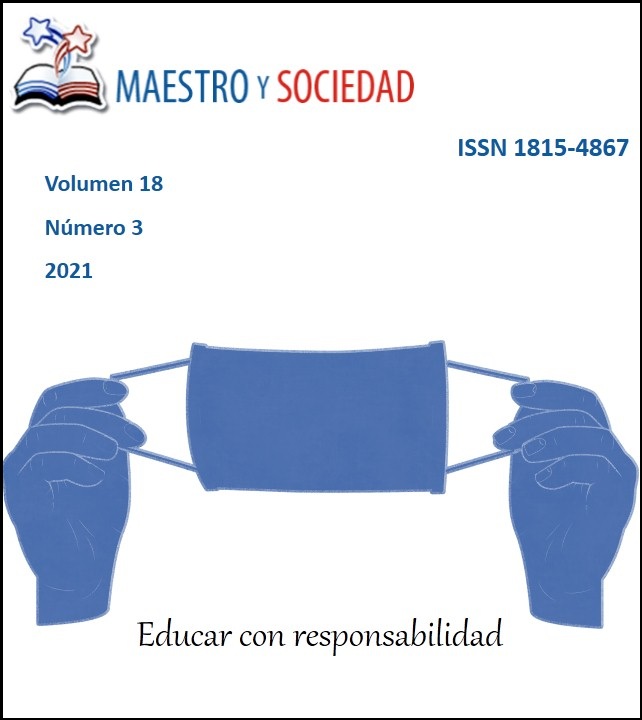Using online authentic materials and language corpus to foster vocabulary acquisition in English
Array
Palabras clave:
online authentic materials, vocabulary, English language teachingResumen
The use of authentic materials in English language teaching has been the focus of study of many professionals of this field. Consequently, researchers have recognised that the use of authentic materials for the acquisition of new vocabulary contributes to the development of reading comprehension skills in students of English-as-a-foreign-language (EFL). This study intends to analyse the theoretical conceptions about teaching vocabulary using online authentic materials and language corpus for language skills development, especially in a world context in which teaching using the benefits of ICT has become an important asset to schools because of the Covid-19 pandemic. The methodology and the main results of a study conducted at the University of Cienfuegos and the University of Oriente are described in the article, as well as the main findings arising from the research.
Citas
2. Abreus González, A., & Haro Calero, R. (2019). El empleo de materiales auténticos audiovisuales para el desarrollo de la expresión oral en inglés: estudio de caso en Ecuador. EDMETIC, Revista de Educación Mediática y TIC, 8(1), 23-35. doi: https://doi.org/10.21071/edmetic.v8i1.10695
3. Abreus González, A.; Marrero Rodríguez, A & Vázquez Cedeño, A. (2011). La integración de habilidades en inglés con fines específicos en la formación del profesional de agronomía. Propuesta de folleto. Cuadernos de Educación y Desarrollo. 3(28).
4. Álvarez Montalvan, F. (2007). El uso de material auténtico en la enseñanza de ELE. FIAPE. II Congreso internacional: Una lengua, muchas culturas. Granada, 26-29/09-2007
5. Bright, J. A., & Mc Gregor, G. P. (1970). Teaching English as a Second Language. Theory and Techniques for the Secondary Stage. Longman.
6. Crandall, B. R., Lewis, E., Stevens, E. Y., Robertson, J. M., O´Toole, J. E., Cullen, K.A., Munger, K. A., Murray, .M. S., Duffy, M. A., Dussling, T. M. & McQuitty, V. (2016) Steps to Success: Crossing the Bridge Between Literacy Research and Practice. SUNY Open Textbooks.
7. Escalona, C. (2017). Las semicognadas inglés-español: análisis de su uso en textos académicos. Revista Santiago, nro Especial, 56-65.
8. Escudero, G. (2006). Machine Learning Techniques for Word Sense Disambiguation. Tesis en opción al título de Doctor en Ciencias Lingüísticas. Universidad de Catalunya.
9. Frege, G. (2013). Sobre significado y sentido. Dulmorth: Editorial Tecnos.
10. McCarthy, M. (1990). Language Learning: A scheme for teacher education. Oxford University Press
11. Motealegre, R. (2004). La comprensión del texto: sentido y significado”. Revista Latinoamericana de Psicología 36 (2), 244-252.
12. Nunan, D. (1989). Designing tasks for the Communicative Classroom. Cambridge University Press
13. Pan Yi-Chun (2017). Teaching Vocabulary to Improve Reading Comprehension. Studies in Literature and Language, 15( 4), 38-40. DOI:10.3968/10013
14. Seifert, S., Kulmhofer, A., Paleczek, L., Schwab, S., & Gasteiger-Klicpera B. (2017). Suggestions for vocabulary focused reading lessons for mainstream classrooms addressing both L1 and L2 learners. Early Childhood Education Journal, 45(3), 333-345.
15. Skell Sketch Engine Online Corpus Dictionary. Recuperado de https://skell.sketchengine.co.uk/un.cgi. Consultado del 15-24 de febrero de 2021.
16. Spratt, M., Pulverness, A. & Williams, M. (2011). The TKT Course (Second Edition). Cambridge University Press
Descargas
Publicado
Cómo citar
Número
Sección
Licencia
Esta revista proporciona un acceso abierto inmediato a su contenido, basado en el principio de que ofrecer al público un acceso libre a las investigaciones ayuda a un mayor intercambio global de conocimiento. Cada autor es responsable del contenido de cada uno de sus artículos. Los artículos pueden ser inéditos o estar disponibles previamente en servidores de preprints reconocidos por la revista. Sin embargo, no se permite la duplicación de la publicación o traducción de un artículo ya publicado en otra revista o como capítulo de un libro.
This journal provides immediate open access to its content, based on the principle that providing the public with free access to research supports a greater global exchange of knowledge. Each author is responsible for the content of each of their articles. Articles may be previously unpublished or available on preprint servers recognized by the journal. However, duplication of publication or translation of an article already published in another journal or as a book chapter is not permitted.
Esta revista oferece acesso aberto imediato ao seu conteúdo, com base no princípio de que oferecer ao público acesso gratuito à pesquisa contribui para um maior intercâmbio global de conhecimento. Cada autor é responsável pelo conteúdo de cada um de seus artigos. Os artigos poderão ser inéditos ou estar previamente disponíveis em servidores de preprints reconhecidos pela revista. No entanto, não é permitida a duplicação de publicação ou tradução de artigo já publicado em outro periódico ou como capítulo de livro.



























 Universidad de Oriente
Universidad de Oriente 